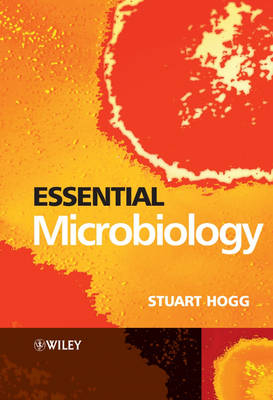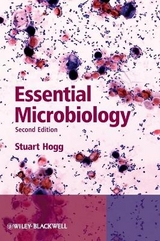
Essential Microbiology
John Wiley & Sons Inc (Verlag)
978-0-471-49753-0 (ISBN)
- Titel erscheint in neuer Auflage
- Artikel merken
"Essential Microbiology" is a comprehensive introductory text aimed at students taking a first course in the subject. Covering all aspects of microbiology, it describes the structure and function of microbes before considering their place in the living world. The second half of the book focuses on applied aspects such as genetic engineering, industrial microbiology and the control of microorganisms. Adopting a modern approach and with extensive use of clear comprehensive diagrams, "Essential Microbiology" explains key topics through the use of definition boxes and end of chapter questions. This book is invaluable for undergraduate students in the biological, food and health sciences taking a first course in Microbiology. It provides comprehensive introduction covering all aspects of this exciting subject. It includes numerous examples and applications from a wide range of fields. It includes definition boxes, key points and self-test questions that enhance student understanding.
Preface. Acknowledgements. PART I: INTRODUCTION. 1. Microbiology: What, Why and How? What is microbiology? Why is microbiology important? How do we know? Microbiology in perspective: to the golden age and beyond. Light microscopy. Electron microscopy. 2. Biochemical Principles. Atomic structure. Acids, bases and pH. Biomacromolecules. Test yourself. 3. Cell Structure and Organization. The procaryotic cell. The eucaryotic cell. Cell division in procaryotes and eucaryotes. Test yourself. PART II: MICROBIAL NUTRITION, GROWTH AND METABOLISM. 4. Microbial Nutrition and Cultivation. Nutritional categories. How do nutrients get into the microbial cell? Laboratory cultivation of microorganisms. Test yourself. 5. Microbial Growth. Estimation of microbial numbers. Factors affecting microbial growth. The kinetics of microbial growth. Growth in multicellular microorganisms. Test yourself. Chapter 6. Microbial Metabolism. Why is energy needed? Enzymes. Principles of energy generation. Anabolic reactions. The regulation of metabolism. Test yourself. PART III: MICROBIAL DIVERSITY, A FEW WORDS ABOUT CLASSIFICATION. 7. Procaryotic Diversity. Domain: Archaea. Domain: Bacteria. Bacteria and human disease. Test yourself. 8. The Fungi. General biology of the Fungi. Classification of the Fungi. Fungi and disease. Test yourself. 9. The Protista. 'The Algae'. 'The Protozoa'. The slime moulds and water moulds (the fungus-like protists). Protistan taxonomy: a modern view. Test yourself. 10. The Viruses. What are viruses? Viral structure. Classification of viruses. Viral replication cycles. Viroids. Prions. Cultivating viruses. Viral diseases in humans. Test yourself. PART IV: MICROBIAL GENETICS. 11. Microbial Genetics. How do we know genes are made of DNA? DNA replication. What exactly do genes do? Regulation of gene expression. The molecular basis of mutations. Genetic transfer in microorganisms. Test yourself. 12. Microorganisms in Genetic Engineering. Introduction. Plasmid cloning vectors. Bacteriophages as cloning vectors. Expression vectors. Eucaryotic cloning vectors. Polymerase chain reaction (PCR). Test yourself. PART V: CONTROL OF MICROORGANISMS. 13. Control of Microorganisms. Sterilization. Disinfection. The kinetics of cell death. Test yourself. 14. Antimicrobial Agents. Antibiotics. Resistance to antibiotics. Antibiotic susceptibility testing. Antifungal and antiviral agents. The future. Test yourself. PART VI. MICROORGANISMS IN THE ENVIRONMENT. 15. Microbial Associations. Microbial associations with animals. Microbial associations with plants. Microbial associations with other microorganisms. Test yourself. 16. Microorganisms in the Environment. The carbon cycle. The nitrogen cycle. The sulphur cycle. Phosphorus. The microbiology of soil. The microbiology of freshwater. The microbiology of seawater. Detection and isolation of microorganisms in the environment. Beneficial effects of microorganisms in the environment. Harmful effects of microorganisms in the environment. Test yourself. PART VII: MICROORGANISMS IN INDUSTRY. 17. Industrial and Food Microbiology. Microorganisms and food. Microorganisms as food. The microbial spoilage of food. Microorganisms in the production of biochemicals. Products derived from genetically engineered microorganisms. Microorganisms in wastewater treatment and bioremediation. Microorganisms in the mining industry. Test yourself. Glossary. Appendix. Further Reading. Index.
| Erscheint lt. Verlag | 22.7.2005 |
|---|---|
| Zusatzinfo | Illustrations |
| Verlagsort | New York |
| Sprache | englisch |
| Maße | 176 x 254 mm |
| Gewicht | 976 g |
| Themenwelt | Naturwissenschaften ► Biologie |
| ISBN-10 | 0-471-49753-3 / 0471497533 |
| ISBN-13 | 978-0-471-49753-0 / 9780471497530 |
| Zustand | Neuware |
| Haben Sie eine Frage zum Produkt? |
aus dem Bereich



